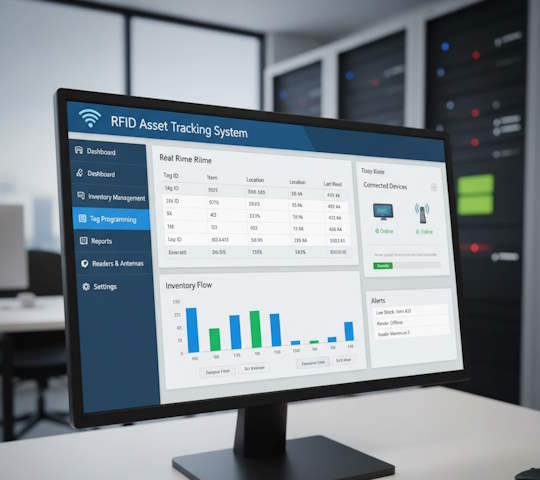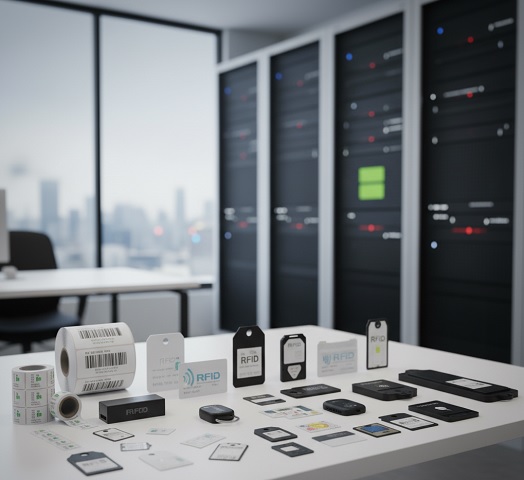UHF RFID for Moving Companies in the United States
The US moving industry handles tens of millions of moves annually. Manual paperwork and spot inventories create delays, shrink margins, and damage reputations. UHF RFID brings real‑time, item‑level visibility to every stage of a residential or commercial move, reducing lost items, speeding operations, and delivering measurable financial benefits.
Technical overview of UHF RFID
- Frequency and standard: UHF RFID typically operates in the 860–960 MHz band and is standardized by EPC Gen2 / ISO 18000‑63.
- System components: tags (usually passive UHF tags with EPC/ID), readers (fixed and handheld), antennas (directional and panel), and middleware that filters events and integrates with TMS/ERP.
- Performance traits: read ranges of up to several meters, simultaneous multi‑tag reads, tag memory up to a few hundred bits for basic metadata, and sensitivity to materials such as metal and liquids that requires tag and placement testing.
- Vendors and hardware: leading suppliers include Impinj, Zebra Technologies, Honeywell, and Siemens for readers and ecosystem components.
How UHF RFID improves moving operations
- Fast, accurate inventories: what used to take hours can be completed in minutes by scanning tagged boxes and furniture; item‑level records with photos and descriptions eliminate manual transcription errors.
- Secure chain of custody: automated reads at loading, en route checkpoints, and unloading provide an auditable movement log that reduces lost or misdelivered items.
- Condition and environment monitoring: pairing RFID with temperature and humidity sensors preserves sensitive shipments and documents claims data.
- Warehouse and storage optimization: instant search among thousands of stored items, automated storage period tracking, and large labor savings during in/outbound handling.
Industry use cases and impact examples
- Loading docks and pickup: fixed readers at loading bays validate complete manifests and prevent under‑ or overloading.
- Transit tracking: mobile readers and gateway checkpoints update shipment location and condition in real time.
- Short‑term storage for clients: rapid retrieval and automated billing based on storage duration.
- Customer visibility: customer‑facing mobile integrations let clients follow their inventory during transit and storage, improving trust and referrals.
Representative impacts seen in industry deployments:
- Inventory accuracy rising from mid‑80s percent to above 99.5%.
- Order processing and handling time reductions of 40–70%.
- Insurance claims and loss incidents dropping substantially, often cutting claim‑related payouts by tens of percent.
- Demonstrable cost recovery with pilot ROI windows commonly in the 6–24 month range depending on scale.
Implementation roadmap and common pitfalls
- Define the business case and KPIs: lost‑item rate, inventory accuracy, cycle time, and insurance exposure.
- Run a focused pilot: one route, one warehouse, or one service line to validate tags, readers, and processes.
- Test tags in real conditions: evaluate tag attachment, orientations, and performance on furniture, boxes, and pallets.
- Tune reader and antenna layouts: avoid unwanted reads (cross‑reads) and create deterministic read zones.
- Integrate middleware with TMS/ERP: design event filters and exception workflows; expose customer status updates if needed.
- Train staff and adapt processes: operational change management is as important as hardware selection.
- Scale iteratively: use pilot results to refine ROI models and rollout priorities.
Common mistakes: skipping realistic tag tests, underestimating integration complexity, lacking clear KPIs, and not training crews on new workflows.
Measuring ROI and key metrics
- Inventory accuracy: target 99%+ for tagged SKUs.
- Cycle time: measure pickup/load and delivery/unload time per job; expect large reductions.
- Loss and claim rate: track incidents per 1,000 moves and claim cost trends.
- Labor hours saved: convert reduced manual counting and reconciliation into labor cost savings.
- Payback period: typical pilots return investment within 6–24 months depending on move volume and scope of automation.
Future trends
- IoT convergence: hybrid solutions combining RFID with BLE beacons, GPS, and environmental sensors for enriched tracking.
- Cloud analytics and predictive risk models: use movement history and environmental data to predict damage risk and optimize routing.
- Immutable audit trails: blockchain registers for tamper‑resistant custody histories in high‑value moves or legal disputes.
- Customer experience platforms: integrated mobile tracking and notifications that drive referrals and higher Net Promoter Scores.
Conclusion
UHF RFID is not a theoretical improvement but a practical tool that modern moving companies can deploy to reduce losses, speed operations, and differentiate by transparency. Start small, measure rigorously, and scale based on validated ROI.
FAQ
-
How does RFID reduce lost items
RFID creates continuous read checkpoints from packing to delivery, making omissions and swaps detectable in real time. -
Can RFID integrate with existing TMS and ERP
Yes, most middleware solutions provide connectors or APIs to forward normalized RFID events to TMS/ERP platforms. -
What is the typical pilot budget
A small pilot in the US commonly starts around USD 20,000 but varies by scope and hardware choices. -
Are RFID tags reusable
Many UHF tags are reusable; selection depends on durability and form factor. -
How accurate is RFID inventory
Properly configured systems routinely achieve 99.5–99.8% accuracy for tagged items.
Sources
- American Moving & Storage Association (AMSA)
- GS1 EPCglobal Standards
- Logistics Management Institute (LMI)
- Zebra Technologies – RFID Solutions
- Impinj RFID Systems
- Honeywell RFID Technology
- Siemens Logistics




